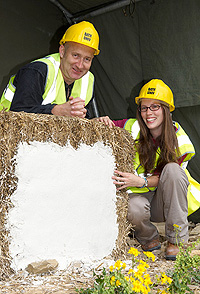Jul 16 2009
Could straw houses be the buildings of the future? That's what researchers at the University of Bath will be testing this summer by constructing a "BaleHaus" made of prefabricated straw bale and hemp cladding panels on campus.
 Professor Pete Walker and Dr Katharine Beadle are investigating straw bales as a building material (Credit: Nic Delves-Broughton)
Professor Pete Walker and Dr Katharine Beadle are investigating straw bales as a building material (Credit: Nic Delves-Broughton)
And people around the world will be able to watch its progress online via "Strawcam" from Monday 20 July at: www.bath.ac.uk/features/balehaus/
- part of a site which will also feature blogs, videos, photos and lots of other information about the project.
Straw is the ultimate environmentally-friendly building material since it is renewable and is a by-product of farming.
The crop used for the straw can be grown locally, and because it absorbs carbon dioxide as it grows, buildings made from it can be seen as having zero, or even a negative carbon footprint.
Also, due to its high insulating properties, houses made of straw bales need almost no conventional heating, keeping running costs low and minimising environmental impact.
The research team will be assessing straw bales and hemp as building materials so that they can be used more widely in the building industry for housing, helping the UK achieve its targets for reducing carbon emissions.
The two storey BaleHaus to be built on campus will be made using 'ModCell' - pre-fabricated panels consisting of a wooden structural frame infilled with straw bales or hemp and rendered with a breathable lime-based system.
ModCell is the creation of White Design in Bristol and Integral Structural Design in Bath. Other partners on the research project are Agrifibre Technologies, Lime Technology, Eurban, the Centre for Window & Cladding Technology and Willmott Dixon.
Some of the building has already appeared in the media spotlight. Last year the team helped Kevin McCloud, presenter of Channel 4's Grand Designs programme, to build an eco-friendly house in six days using ModCell panels for the Grand Designs Live exhibition.
All the wall panels used for the ground floor of the Grand Designs house are being reused for the BaleHaus at Bath.
Professor Pete Walker, Director of the BRE Centre in Innovative Construction Materials at the University of Bath, said: "Up to this point straw bales have not really been seen as a credible building material by much of the industry, even though straw has always been used in building for centuries, and straw bales have been used for about 100 years.
"Straw bales are an agricultural by-product and the material can be re-grown so is totally sustainable and renewable. The straw can be grown on a farm that is local to the construction site which saves on transport and minimises the carbon footprint of the building.
"Standard bales are 450 mm thick and provide very high levels of insulation so you need very little additional heating."
The BaleHaus at Bath, due to be completed in the late summer, will be monitored for a year for its insulating properties, humidity levels, air tightness and sound insulation qualities.
Dr Katharine Beadle, the principle researcher on the project, explained: "We're putting sensors into the walls to monitor temperature and humidity levels, and using technology to simulate the heat and moisture generated by people."
Craig White, Director of White Design and ModCell said: "The Zero Carbon Housing challenge the industry faces is not going to be met with conventional design and materials.
"BaleHaus at Bath is an entirely new and renewable way to construct homes fit for the challenge.
"Made from natural materials that are beautiful, affordable and sustainable, BaleHaus is a living, breathing home that is cool in summer and warm in winter, helps families reduce their CO2 footprint without compromising how they choose to live their lives and sets a new and very different benchmark for sustainable homes in the 21st century."
From 20 July people will be able to log on to www.bath.ac.uk/features/balehaus/strawcam to watch the progress of the build via "Strawcam". The site will also feature blogs, videos, photos and further information about the project.